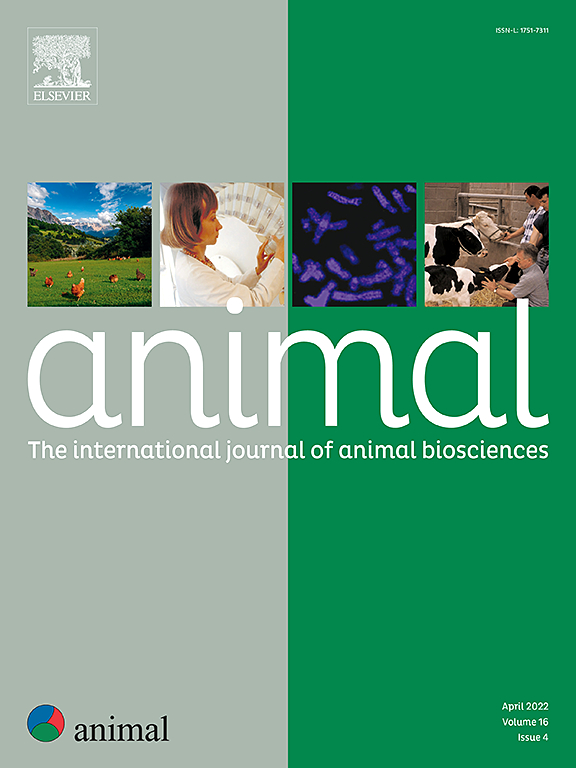A case-control genome-wide association study of estimated breeding values for resistance to gastrointestinal nematodes in two local dairy sheep breeds
IF 4
2区 农林科学
Q1 AGRICULTURE, DAIRY & ANIMAL SCIENCE
引用次数: 0
Abstract
In sheep, gastrointestinal nematodes (GINs) can cause disease, reduced feed intake, and nutritional deficiencies. To counteract GINs, anthelmintics are widely used although it is well known they may enter the environment impacting ecosystems. In addition, anthelmintics resistance has rapidly developed and consequently, alternative approaches are crucial for profitable and sustainable sheep production. The occurrence of resistant individuals is mainly due to their intrinsic genetic diversity; therefore, the implementation of breeding plans for resistant animals may provide a promising strategy to reduce the use of anthelmintics. This study is aimed at identifying genomic regions involved in sheep resistance to GINs. To do this, faecal samples were collected from 642 Comisana and 323 Massese sheep over 3 years to assess Faecal Egg Counts, and Estimated Breeding Values (EBVs) for GIN resistance were estimated by a repeatability animal model. Then, EBVs in the 99.95th and 0.05th percentiles were used to identify the most and least “genetically resistant” individuals to GINs, using genotyped individuals with the Illumina OvineSNP50 beadchip. A genome-wide case-control analysis was performed retaining the most significant single nucleotide polymorphisms (SNPs) with a threshold of 0.005% for the false discovery rate. Genes and Quantitative Trait Loci overlapping significant SNPs were annotated and enriched respectively while genes have been also enriched for functional pathways. As a result, 13 genes on 12 chromosomes and 10 genes on 11 different chromosomes were identified in the Comisana and Massese breed, respectively. Among these, genes involved in the physiology or pathology of the gastrointestinal tract, in adaptive processes and in production traits, were detected. The enrichment analysis highlighted 36 significant pathways in the Comisana breed and 21 in the Massese breed. Many of these pathways were involved in the regulation of the immune response, drug metabolism and detoxification, and vitamin metabolism. Interestingly, pathways involved in vitamin and drug metabolism were also identified in previous research and have shown to play an active role in GIN resistance. In this study, we took advantage of the use of EBVs as a metric for GIN resistance in a case-control genome-wide framework and successfully identified several genomic regions that might be involved in the trait. The presence of overlapping functional pathways related to different genes in the two breeds seems to reinforce the idea of the polygenicity of this trait, and further studies are needed in order to make selection schemes an effective tool to contrast GINs.
对两个地方奶羊品种胃肠道线虫抗性育种价值的病例对照全基因组关联研究
在绵羊中,胃肠道线虫(GINs)可引起疾病、采食量减少和营养缺乏。为了对抗GINs,人们广泛使用驱虫药,尽管众所周知它们可能会进入环境影响生态系统。此外,抗虫药耐药性已迅速发展,因此,替代方法对于盈利和可持续的绵羊生产至关重要。抗性个体的产生主要是由于其内在的遗传多样性;因此,实施抗性动物育种计划可能为减少驱虫剂的使用提供一种有希望的策略。本研究旨在确定与绵羊对GINs抗性有关的基因组区域。为此,研究人员在3年内收集了642只Comisana羊和323只Massese羊的粪便样本,以评估粪卵数量,并通过可重复性动物模型估计GIN抗性的估计育种值(ebv)。然后,使用Illumina OvineSNP50头芯片进行基因分型,利用99.95和0.05百分位的ebv鉴定对GINs“遗传抗性”最高和最低的个体。进行全基因组病例对照分析,保留最显著的单核苷酸多态性(snp),错误发现率阈值为0.005%。重叠显著snp的基因和数量性状位点分别被注释和富集,功能通路的基因也被富集。结果表明,在Comisana和Massese品种中分别鉴定出12条染色体上的13个基因和11条不同染色体上的10个基因。在这些基因中,检测到参与胃肠道生理或病理,适应过程和生产性状的基因。富集分析显示,Comisana品种中有36条显著途径,Massese品种中有21条显著途径。许多这些途径参与调节免疫反应,药物代谢和解毒,以及维生素代谢。有趣的是,先前的研究也发现了与维生素和药物代谢有关的途径,并表明这些途径在GIN耐药性中发挥积极作用。在这项研究中,我们利用ebv作为病例对照全基因组框架中GIN抗性的度量标准,成功地确定了可能与该性状有关的几个基因组区域。两个品种中与不同基因相关的重叠功能通路的存在似乎强化了这一性状的多基因性,为了使选择方案成为比较GINs的有效工具,需要进一步的研究。
本文章由计算机程序翻译,如有差异,请以英文原文为准。
求助全文
约1分钟内获得全文
求助全文
来源期刊

Animal
农林科学-奶制品与动物科学
CiteScore
7.50
自引率
2.80%
发文量
246
审稿时长
3 months
期刊介绍:
Editorial board
animal attracts the best research in animal biology and animal systems from across the spectrum of the agricultural, biomedical, and environmental sciences. It is the central element in an exciting collaboration between the British Society of Animal Science (BSAS), Institut National de la Recherche Agronomique (INRA) and the European Federation of Animal Science (EAAP) and represents a merging of three scientific journals: Animal Science; Animal Research; Reproduction, Nutrition, Development. animal publishes original cutting-edge research, ''hot'' topics and horizon-scanning reviews on animal-related aspects of the life sciences at the molecular, cellular, organ, whole animal and production system levels. The main subject areas include: breeding and genetics; nutrition; physiology and functional biology of systems; behaviour, health and welfare; farming systems, environmental impact and climate change; product quality, human health and well-being. Animal models and papers dealing with the integration of research between these topics and their impact on the environment and people are particularly welcome.
 求助内容:
求助内容: 应助结果提醒方式:
应助结果提醒方式:


